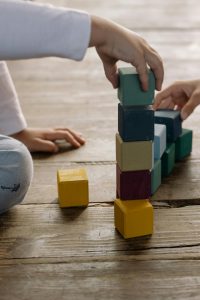When STEM Meets Early intervention: The One Webinar Series Every Early Intervention Provider Needs This Year
Posted on August 20, 2025 in Practice

Are you an early intervention (EI) provider or home visitor working with infants and toddlers with developmental delays? STEMIE has launched a new webinar series that could transform your practice, helping you see and support children’s thinking through a STEM lens.
As an EI provider, you may wonder: “What does STEM have to do with my work?” This is one of the most common questions we hear when we start talking about STEM in early intervention. Many people picture STEM as activities older children do,, such as writing code, solving math problems, or conducting science experiments. But for infants and toddlers, STEM is not a “subject” to deliver—it’s a lens for deepening the parent-child interactions that are already happening, bolstering opportunities for children to develop the thinking skills that will serve them for years to come
 Take mealtime, for example. When a baby repeatedly drops a spoon or fork onto the floor, they’re experimenting. They’re curious about what happens to the spoon, why it makes a sound when it hits the floor, and what will happen if they try it again. In that moment, they’re exploring cause and effect, force and motion, and observing changes—all foundational skills for learning about future STEM thinking skills.
Take mealtime, for example. When a baby repeatedly drops a spoon or fork onto the floor, they’re experimenting. They’re curious about what happens to the spoon, why it makes a sound when it hits the floor, and what will happen if they try it again. In that moment, they’re exploring cause and effect, force and motion, and observing changes—all foundational skills for learning about future STEM thinking skills. 
Not only can STEM learning happen everywhere—it can also be a powerful vehicle for supporting a wide range of developmental outcomes. Take stacking blocks, for example. It’s a common STEM activity not only for preschoolers but also for infants and toddlers. Young children love stacking two or three blocks, then knocking them over and giggling as they watch them fall. But beyond the fun, think about the learning that’s happening:
-As children stack, they are practicing eye-hand coordination and grasping skills.
-As adult partners talk about what is happening, children learn new words and concepts, and have opportunities to use language to make things happen (“Ready, Set…..GO!”).
With simple scaffolding strategies that focus on STEM thinking, a simple block-stacking game becomes a rich opportunity to support motor, cognitive, and communication development.
This block-stacking example is just one illustration of how everyday routines can become powerful STEM learning opportunities when approached with intentional strategies. In this webinar series, we’ve built on this idea, designing topics that will help you see the connections between STEM and your work in new ways. We’ll move beyond focusing on deficits or the causes of children’s skills, and instead, highlight strategies that build on each child’s interests, strengths, and abilities.
Our goal is to equip you with practical ways to infuse STEM concepts and teaching strategies into everyday routines, creating richer opportunities for children to build their thinking skills and, in turn, foster growth across all areas of development — including motor, communication, and social-emotional skills.
Join us on this journey through our biweekly, one-hour webinar series. If you missed any previous sessions, you can catch up by watching the recordings here: https://stemie.fpg.unc.edu/collection/early-intervention-ei-providers/
For upcoming sessions, there may still be time to register and participate live—check availability and reserve your spot here: https://stemie.fpg.unc.edu/news-items/stem-meets-ei-webinar-series/




